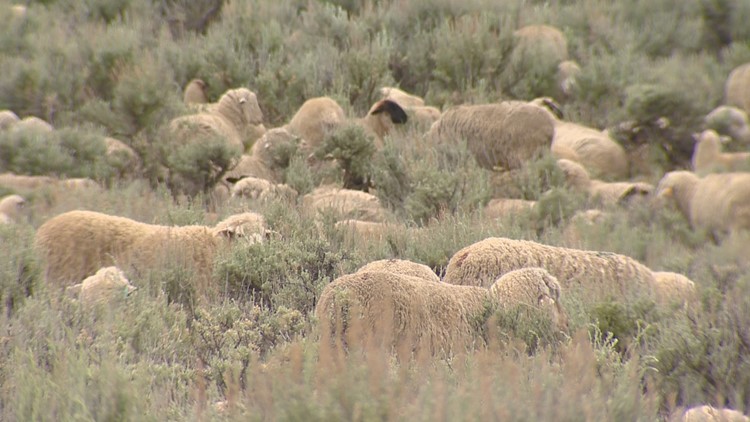BELLEVUE, Idaho (AP) - On a recent Friday morning in September, rancher John Peavey stood waiting outside Wood River Welding on Main Street in Bellevue. His flock, the 2,800 ewes of the Flat Top Sheep Co., was waiting, too, 10 miles south of town. Peavey's trailer broke an axle hauling the metal piping of a portable corral to meet them for shearing, an annual rite of fall.
"The horses, the dogs, the sheep - they seem to get along without any extra effort," he said. "It's this mechanical stuff I'm not so sure about."
Three weeks on from his 85th birthday, Peavey's been in the sheep industry long enough to remember a time before all that.
In the years after the mines went under, and before ski lifts began spinning at Sun Valley, Blaine County belonged to the sheep - and few families around today align as closely with the work as Peavey's.
A century ago, seven years before John's grandfather founded the Flat Top Sheep Co., some 2.65 million sheep lived in Idaho, according to the U.S. Department of Agriculture. They outnumbered people six to one. It would take more than 50 years for humans to catch up, 700,000 to 687,000 in the 1970 Census.
These days, just 230,000 sheep graze throughout the state, per government estimates. Local ranchers pin the decline on international competition, rising costs, depredation, government regulation - and, beyond that, a modern society uninterested in the ancient labor.
But holdouts remain - like Peavey's Flat Top, now managed by his own grandson, the fifth generation to work the land north of Carey, and John Faulkner, of Faulkner Land and Livestock, 86 years old and still following the seasons across the 100 miles between the Snake River Plain and the high alpine ranges of the Sawtooths, as his father did before him.
"A lot changed," Faulkner said. "Sheep are still the same, though. Four footed. Wooly. And I still like them more than cows."
"To get into the sheep business," he added, "you're either born into it or you're a damn fool."
Peavey's grandfather, John Thomas, came to Gooding from Kansas as a banker in 1909. Thomas, who'd go on to serve two nonconsecutive terms in the U.S. Senate, recognized that sheep ranchers could pay off their loans quicker than cattlemen. So, in 1925, he pieced together a ranch of his own. Thomas' personal brand, a capital T with a J flipped horizontally for the top bar, still shows up on some of Peavey's sheep - as well as on the dinner plates at Ketchum's Pioneer Saloon.
"The guys on the ranch helped raise me," Peavey said. "Every summer, we'd come back and spend time out here. I learned to love it, the life, and the lifestyle."
His mother, Mary Elizabeth Thomas Peavey Brooks, managed the ranch from when her father died in 1945 until 1961, when she stepped aside to pursue her own political career, which culminated in eight years heading the U.S. Mint.
But Flat Top was in Brooks' blood. She never left it, or Idaho, behind.
Some 20 years ago, the Ketchum City Council voted not to repaint a blue-and-white sign that read "Eat More Lamb" on the backside of the old J.P. & J.C. Lane Mercantile building on Main Street, now a restaurant and wine bar. Well, the matriarchs of the sheep families wouldn't have it. And Brooks, at 92, went to say so, remembers Diane Peavey, John's wife.
"She told them it was out of the question," Diane said. Ketchum repainted the sign. "We're a family drawn from that line, that life," Diane Peavey said. "We take a lot of pride in it_living it, and defending it."
On Sept. 1, his 85th birthday, John Peavey put the Flat Top rams out with the ewes - "extensive family planning," as he called it, the way they've done for 93 years.
This time, there were some snags. The Sharp's Fire, which burned more than 100 square miles east of Bellevue straight through to the Pioneer Mountains this summer, torched all but two of the canyons on the west side of Flat Top's grazing range.
"It's an odd year to be in sheep ranching, but that's the case every year," Diane Peavey said. "You're waiting for the other shoe to drop, all the time."
"It'll come back," Peavey said. "Fire happens. It'll start to come back together."
Until then, thank God for neighbors.
Peavey got a call from John Fell Stevenson once the fire spread east, offering room and board for the sheep on his fields south of Bellevue. Stevenson's growing season was done, his barley well on its way to becoming Coors. So Peavey, the son of a former head of the U.S. Mint, moved his sheep over the ridgeline to the farm of Stevenson, son of Adlai, former U.S. ambassador to the United Nations and twice a U.S. presidential candidate.
Peavey's gray half-ton pickup kicked a fine scrim of dust as its traversed Stevenson's fallow fields. Hoopes Sheep Shearing, a crew out of Mountain View, Wyoming, waited for him beneath the brows of Timmerman Hill - and so did Flat Top's 2,800 sheep, each awaiting a haircut. Cliff Hoopes' crew would shear 700 per day for the next four days, collecting, if the summer graze went well, 10 pounds of wool off each Rambouillet.
As sheep go, they're big animals. The ewes, smeared gray as storm clouds after months outdoors, weigh around 200 pounds. Add another 100 for the rams, and a set of tapered corkscrew horns, browned to the color of old scrolls. (As is custom, the men stay home on the ranch while the ladies have their hair done.)
Rambouillets are common across the West. Think of them as French cousins to the more famous Spanish merino - noticeably larger and slightly less wooly, but toughened up for the American range.
"They produce fine wool, they're good mothers and they're a good, meaty animal - that helps us," Peavey said. "It's a great meat - the furthest you can get from factory farming - pigs, chickens, all that. These sheep, they do it the way we did it a long time ago."
Unlike cattle, his ewes see a pen once a year, for their annual shearing.
That's Hoopes' specialty. When he hits the road next January, the Hoopes family will have shorn sheep for 130 years. Peavey's portable corral, after it finally arrived, was pieced together to form a series of pens and chutes leading to and from a purple-and-green plywood trailer about the size of a semi. Brands covered the trailer's walls, from each ranch his family business has shorn. The Peaveys' vertical division sign is on it. So is John Thomas' original initials.
"These guys fly all over the goddamn world to shear sheep," Hoopes said. And, faced with a dearth of skilled shearers, he's flown them in from all over to do it, too. He's employed Peruvians, Aussies, Kiwis, South Africans, Falkland Islanders. He's started a paid apprenticeship program to bring new blood into the field.
"It's damn near impossible to find people," he said. "And, it's getting harder - way harder. This generation, they'd rather go flip burgers at McDonalds for 15 bucks an hour. What we're doing is strenuous work."
Nearby, herders hustled a new batch of animals toward the trailer. A racket rose with the dust, peaking in a Spanish chorus: "Andale, Andale - hup-up-up!" Border collies nipped and tugged fleece through cracks in the fencing. Prodded and pushed, the sheep rose and buckled like whitewater toward the mechanical crackle of clippers.
Then, the first sheep rolled through a gap in the side wall to the 4-by-4-foot workspace at a shearer Dave Brennan's feet. Brennan pinned it like some meek wrestler fighting above its weight class. Done right, the main fleece comes off like a jacket, like the animal just rolled out of it, 3 inches of crimped, matted fiber. The ewe, deflated in its fresh, bleached undercoat, is then snapped like a football, pushed between Brennan's legs to a numbered holding pen outside. He threw the fleece down onto a slotted shelf below. Over the generator, the buzz of the shears, the overdriven modern rock radio, he called for another one, and another $2.60 cents in his pocket.
Outside, Hoopes' wife, Dawna, graded the fleece and stacked it in bins: Long and Short. Length depends on the quality of forage. Sheep have their own hierarchy. Their lambs come first, Peavey said, then their own food and water. If they have energy left over, they'll grow wool, longer and finer on better feed. Thin, long-staple wool will become top-end clothing - suits and the like. Shorter, coarser fibers may end up a sweater, or a blanket. Hair is different altogether; it's hollow, and won't take dye, Dawna Hoopes said. She sets that aside, or throws it away.
From there, the fluffy piles are loaded into a hydraulic press, where they're mashed and tarped into 450- to 500-pound bales. Then, it's onto a box truck, and off to market.
Undressed, Peavey's sheep were ready to go, too. Soon, they'd all be loaded on trucks for winter pastures: half to graze standing alfalfa near Bakersfield, California; half to feed on sage and grouse plant in the BLM land south of Wells, Nevada. There, they'll have their winter lambs. They'll start to grow new coats for the next season. And, on April 1, they'll come back to Idaho, and the Flat Top Ranch, where John Peavey will be waiting.
But for now, he tipped back his gray cowboy hat - or is it white, and coated with the fine dust of the field? He took off his gloves, and set down his crooked wood cane, which he doesn't need, though sometimes the sheep do. And he looked out on his flock, then the amber hillside beyond it, blown smooth and cool by the northwestern wind.
"I think there's some intrinsic value in the way we do it," he said. "There's something in all of this. Sheep ranching in Blaine County, it's a wonderful place to do it. We're trying to survive."



